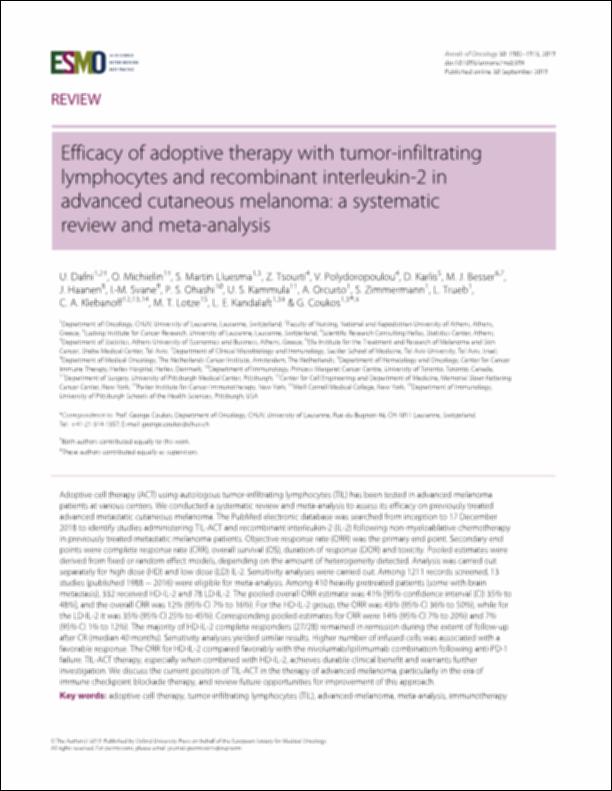Por favor, use este identificador para citar o enlazar este ítem:
http://hdl.handle.net/10637/15063Efficacy of adoptive therapy with tumor-infiltrating lymphocytes and recombinant interleukin-2 in advanced cutaneous melanoma: a systematic review and meta-analysis
| Título : | Efficacy of adoptive therapy with tumor-infiltrating lymphocytes and recombinant interleukin-2 in advanced cutaneous melanoma: a systematic review and meta-analysis |
| Autor : | Dafni, Urari Michielin, O. Martín Lluesma, Silvia Tsourti, Z. Polydoropoulou, V. Karlis, D. Besser, M. J. Haanen, J. Svane, I. M. Ohashi, P. S. Kammula, U. S Orcurto, A. Zimmermann, Sabine D. Trueb, L. Klebanoff, C. A. Lotze, M. T. Kandalaft, Lana E. Coukos, George |
| Materias: | Adoptive cell therapy; Tumor-infiltrating lymphocytes (TIL); Advanced-melanoma; Meta-analysis; Immunotherapy |
| Editorial : | Elsevier |
| Citación : | Dafni U, Michielin O, Lluesma SM, Tsourti Z, Polydoropoulou V, Karlis D, Besser MJ, Haanen J, Svane IM, Ohashi PS, Kammula US, Orcurto A, Zimmermann S, Trueb L, Klebanoff CA, Lotze MT, Kandalaft LE, Coukos G. Efficacy of adoptive therapy with tumor-infiltrating lymphocytes and recombinant interleukin-2 in advanced cutaneous melanoma: a systematic review and meta-analysis. Ann Oncol. 2019 Dec 1;30(12):1902-1913. doi: 10.1093/annonc/mdz398. PMID: 31566658. |
| Resumen : | Adoptive cell therapy (ACT) using autologous tumor-infiltrating lymphocytes (TIL) has been tested in advanced melanoma patients at various centers. We conducted a systematic review and meta-analysis to assess its efficacy on previously treated advanced metastatic cutaneous melanoma. The PubMed electronic database was searched from inception to 17 December 2018 to identify studies administering TIL-ACT and recombinant interleukin-2 (IL-2) following non-myeloablative chemotherapy in previously treated metastatic melanoma patients. Objective response rate (ORR) was the primary end point. Secondary end points were complete response rate (CRR), overall survival (OS), duration of response (DOR) and toxicity. Pooled estimates were derived from fixed or random effect models, depending on the amount of heterogeneity detected. Analysis was carried out separately for high dose (HD) and low dose (LD) IL-2. Sensitivity analyses were carried out. Among 1211 records screened, 13 studies (published 1988 2016) were eligible for meta-analysis. Among 410 heavily pretreated patients (some with brain metastasis), 332 received HD-IL-2 and 78 LD-IL-2. The pooled overall ORR estimate was 41% [95% confidence interval (CI) 35% to 48%], and the overall CRR was 12% (95% CI 7% to 16%). For the HD-IL-2 group, the ORR was 43% (95% CI 36% to 50%), while for the LD-IL-2 it was 35% (95% CI 25% to 45%). Corresponding pooled estimates for CRR were 14% (95% CI 7% to 20%) and 7% (95% CI 1% to 12%). The majority of HD-IL-2 complete responders (27/28) remained in remission during the extent of follow-up after CR (median 40 months). Sensitivity analyses yielded similar results. Higher number of infused cells was associated with a favorable response. The ORR for HD-IL-2 compared favorably with the nivolumab/ipilimumab combination following anti-PD-1 failure. TIL-ACT therapy, especially when combined with HD-IL-2, achieves durable clinical benefit and warrants further investigation. We discuss the current position of TIL-ACT in the therapy of advanced melanoma, particularly in the era of immune checkpoint blockade therapy, and review future opportunities for improvement of this approach. |
| URI : | http://hdl.handle.net/10637/15063 |
| Derechos: | http://creativecommons.org/licenses/by-nc-sa/4.0/deed.es |
| ISSN : | 1569-8041 |
| Fecha de publicación : | 1-dic-2019 |
| Centro : | Universidad San Pablo-CEU |
| Aparece en las colecciones: | Medicina |
Los ítems de DSpace están protegidos por copyright, con todos los derechos reservados, a menos que se indique lo contrario.


